Zerynthia rumina
Zerynthia rumina, the Spanish festoon, is a butterfly belonging to the family Papilionidae. It is a widespread species in Spain and frequents most habitats.
| Zerynthia rumina | |
|---|---|
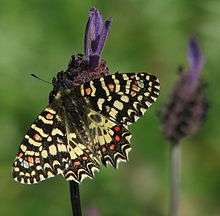 | |
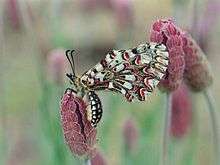 | |
| Scientific classification | |
| Kingdom: | |
| Phylum: | |
| Class: | |
| Order: | |
| Family: | |
| Genus: | |
| Species: | Z. rumina |
| Binomial name | |
| Zerynthia rumina | |
Distribution
North Africa, the Iberian Peninsula and southern France.
Description
Zerynthia rumina is an extremely striking species. In south east France it can be confused with the southern festoon (Zerynthia polyxena). The two can be told apart by the presence of blue on the hindwing of the southern festoon. The Spanish festoon also has extensive red on the forewings.
 Male
Male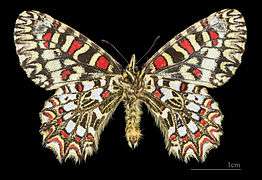 Male underside
Male underside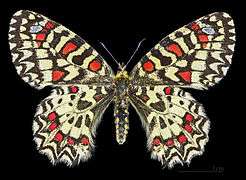 Female
Female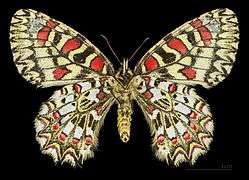 Female underside
Female underside
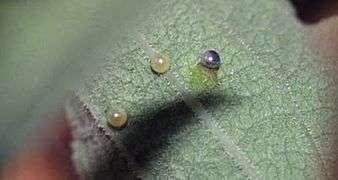 Eggs
Eggs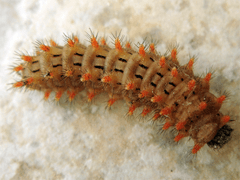 Caterpillar
Caterpillar
Flight period
The flight period is generally in April and May with the possibility of a very small second brood in September.
Roger Verity Collection in La Specola, form names of Zerynthia
Synonymy
This species represents an extreme example of oversplitting.
- rumina Linnaeus (=andalusica Ribbe 1910) (south Spain: Andalusia.
- form tristis Verity
- form semitristis de Sagorra, 1930
- form xanthe Schultz, 1908 (mackeri Holland, 1910)
- form rubistriga Bryk
- form honorathii Boisduval, 1832
- form ochracea Staudinger, 1861
- form medicaste Illiger
- form andalusica Ribbe, 1910
- form paucipunctata Neuburger
- form minusculus Eisner
- form lusitanica Bryk, 1932 (Portugal:Lissabon, Algarve, Cintra, Belem, Oporto, Leca)
- form semitristis de Sagarra, 1930
- form paucipunctata Neuburger
- form ornatissima Blachier, 1908
- form nigricans Eisner
- form minusculus Eisner
- form aperta Eisner
- form divisa Schultz, 1908
- form canteneri Staudinger, 1861
- ornatior Blachier, 1905 = africana (Stichel, 1907), = mauretanica Schultz, 1908 (Northern Africa: Algeria, Morocco: Tangier). The name ornatior is not the correct one for the northern African representative. canteneri (Heydenrich i.l.) Staudinger, 1861 (= canteneri Heyd. 1851, was originally applied to African populations and is the valid name, c.f. Cajetan Felder and Rudolf Felder (1864), Rothschild (1917), canteneri is generally considered a European form but the type locality was fixed 'Algeria' by Cajetan and Rudolf Felder (l.c.) whereas Staudinger (1861) only, and apparently erroneously, referred the name to the Iberian form ochracea. Manley and Allcard (1970) following Bryk (1934) referred to canteneri Staudinger as an orange aberration of both sexes which is frequent in Morocco but occasionally appears in warmer parts of south Spain.
- form irregularis Holland, 1912
- form distorta Rothschild, 1918
- form ornatissima Blachier, 1908
- form nebulosa Holland, 1912
- form xanthe Schultze, 1908
- form honorathii Boisduval, 1832
- form poujadei Thierry-Meg, 1910
- form canteneri Staudinger, 1861
- form nigricans Holland, 1912
- form minusculus Eisner
- form posteriorrubromarginalis Eisner
- form paucipunctata Neuburger
gollark: ++protocol_epsilon 398dddeac6333b99915b3a4f22c1a70c152e0aeef62bbe4fe2038696f2e7eb0b
gollark: OR CAN IT?
gollark: I have AutoBotRobot, but it can't randomly execute things.
gollark: ++supported_langs q
gollark: ++exec```pythonimport esolangs_discordprint(esolangs_discord.get_roles())```
References
- Gil-T., F., 2008: The form canteneri Staudinger of Zerynthia rumina L., an interesting case of sex-linked inheritance: a study of its occurrence in captive-bred specimens and notes about other forms and aberrations (Lepidoptera: Papilionidae). ISSN 0171-0079 | Atalanta 39 (1/4): 337-342, 421. Full article: .
External links

- TOL
- Zerynthia rumina on Guy Padfield's Butterfly Page
- Globis Gart
This article is issued from Wikipedia. The text is licensed under Creative Commons - Attribution - Sharealike. Additional terms may apply for the media files.